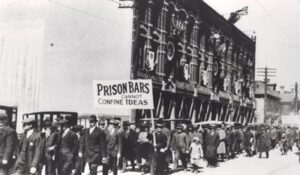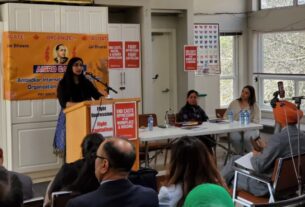
To mark 150 years of the Canadian state, we are publishing some of the articles from our magazine that covered different parts of Canada’s history.
Working people built Canada – physically and politically. For most of Canada’s history, life for workers was hard and wages were low. The government regularly crushed strikes and killed workers. Yet, school history books rarely tell of the many workers’ struggles.
Slowly and painfully, through many bitter struggles, the working class built unions, political parties and other organizations that changed society. Working people won public health, democratic rights, workplace safety, holidays and weekends, and many other social benefits that are part of the fabric of Canada today. Only after World War II did the majority of Canadians win something resembling a decent quality of life.
Early unions, illegal until 1872, were mainly local and covered skilled workers, a minority of workers. The Knights of Labour, the first significant attempt to organize regardless of skill, gender or race, had 20,000 Canadian members by the 1880s, but declined soon after.
After the slaughter of World War I and inspired by the Russian Revolution, militancy and union membership grew rapidly, peaking with the 1919 Winnipeg General Strike. The democratic Strike Committee coordinated essential services, virtually running the city. The Canadian government crushed the strike and killed one person.
The Communist Party, founded in 1921, helped build militant unions, in spite of constant state harassment.
Employers’ and government attacks in the 1920s pushed back unions. During the “hungry thirties” 25% of workers were unemployed in desperate poverty. The Cooperative Commonwealth Federation (forerunner of the NDP) was a product of the grim times. Its 1933 Regina Manifesto stated, “No CCF Government will rest content until it has eradicated capitalism.”
As the economy recovered and workers were re-employed, a powerful desire to organize grew. The victory of the two-week Oshawa GM strike in 1937 was a crucial breakthrough.
During World War II union membership increased and workers struck. The 1945 victory of the 99-day strike at Ford’s Windsor plant established unions as part of Canada’s landscape. While the Canadian state and employers had to accept unions and broad social benefits, they wanted tame unions. The Liberal government smashed the militant Canadian Seamen’s Union in 1949 using a scab US union and gangsters.
In Québec, the bitter and illegal Asbestos strike of 1949 began to break the right-wing’s grip on society. The Quiet Revolution, including mass unionization, by the 1970s radically changed Québec. The Common Front of joint militant union struggles won better wages and reforms that benefited all.
The 1965 illegal strike by the Canadian Postal Workers won union rights, the right to strike, and higher wages. This victory led to widespread unionization across all levels of the public sector and to women now being the majority of union members.
Union density peaked at 37% in 1982. In 1983, the union leaders’ betrayal of BC’s Solidarity movement helped pave the way to widespread neoliberal attacks.
Unions now have fewer activists, are less militant and density is 32%. They risk continued decline unless they return to the struggle and solidarity that built them. Canadian unions are undefeated and have enormous potential power.



